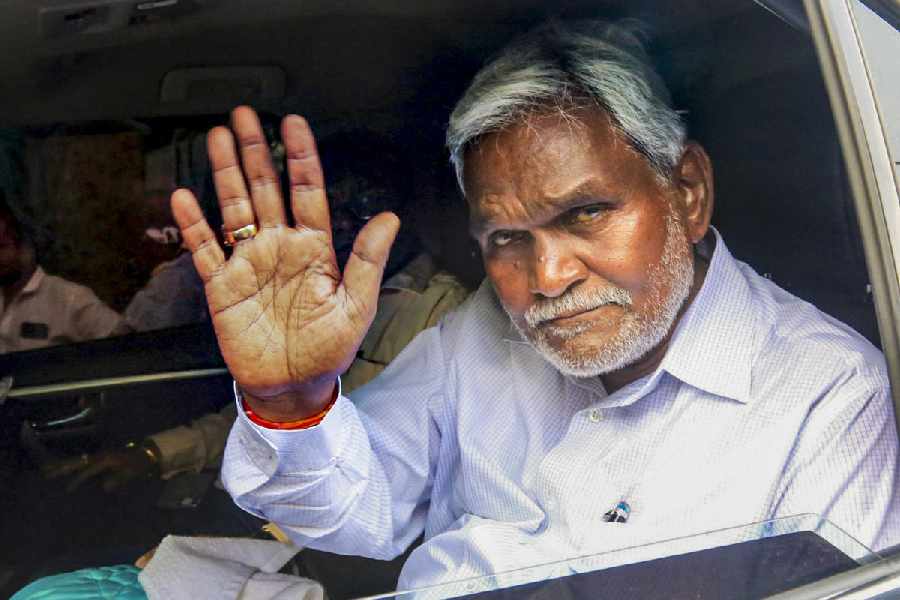 |
 |
| Valli and Gill (above) are rising stars in the world of photography; Photograph courtesy: Charan Singh |
They speak in distinct voices. One attempts to draw intimate photo portraits of ordinary people and places. The other’s more comfortable controlling the environment and captures elaborately staged images with her camera. Yet, Gauri Gill and Nandini Valli both create powerful photographic images that evoke strong emotions.
The two young photographers only entered the gallery space four years ago. But already, they’ve emerged as among the most exciting new voices in Indian photography. They’re making their mark at home and abroad. And now, they’ve both been nominated for the prestigious Grange Prize in Canada.
Says curator Gayatri Sinha: “Gauri and Nandini are among the most successful and distinctive photography talents in India today.”
Both are creating rivetting images. At the Art Gallery of Ontario, where their works are currently showing for the Grange Prize, which is decided by public voting, it’s hard to miss Valli’s image of a richly bejewelled blue-bodied Krishna striking a pose of disillusionment and introspection in a modern-day hotel room setting. And in one of Gill’s prominent works, the camera seeks a poignantly stoic woman perched amidst the thick foliage of a tree. Here, the setting’s rural Rajasthan but the hardy landscape has been bleached of all colour by Gill.
“They address two leading strains in photography practice. Gauri has a strong understanding of photojournalism, Nandini works with the performative photograph,” says Sinha.
 |
| Gill provides glimpses into the lives of the nomadic people of western Rajasthan through intimate portraits like this one titled Ismat, Barmer, from the series Notes From The Desert, 1999-2000 Photograph courtesy: Gauri Gill |
Indeed, Valli’s famed Krishna series, titled Definitive Reincarnate, has established her command over her work. Her rich images are carefully constructed. And Gill has an extensive body of work ranging from her intimate portraits of the nomadic communities of western Raj-asthan to her documentation of the Indian Diaspora in the US and the displaced Afghan Sikh community in Delhi to the landscape of Nizamuddin at Night.
Both are deeply engaged in their medium. Sinha believes that the “sensitivity and evocative power” of their works makes it “distinct”.
Take Gill, who first participated in a group show curated by Sinha in 2007. She quickly established herself with a solo show on the Indian Diaspora titled The Americans at Delhi’s Nature Morte gallery in 2008. Last year, she showed her other large series, Notes from the Desert. She’d worked on both series for 10 years before showing them. “Normally a young photographer will show what is like the first chapter. Here, she was laying out an entire magnum opus — three or four bodies of work, complete and beautifully edited. This kind of revelation of talent is a curator’s dream,” recalls Sinha.
Nature Morte’s Peter Nagy says Gill “showed me places and people I’d normally never see”. “Her involvement with her subjects is striking,” he adds.
 |
| Valli works with elaborately staged images as in Disillusioned 1, 2003, from the Definitive Reincarnate series, which captures Krishna in contemporary settings. Photograph Courtesy: Nandini Valli Muthiah |
Take Gill’s Notes from the Desert series, which comprises compassionate portraits of the Jogi nomads, Muslim migrants and Bishnoi peasants whom she befriended and who let her into their lives. The series began accidentally in 1999, when, while holidaying, Gill saw a girl being beaten by her village school teacher. That led her to take a sabbatical from work — she’d studied photography at the Parsons School of Design, New York, and was working with Outlook magazine from 1995 to 2000 — and visit village schools in western Rajasthan.
Over the next 12 years from 1999 — in between, she went back to the US to do a master’s at Stanford in 2000 — Gill kept revisiting the region, following her “friends” and capturing their lives through birth and death, flood and drought, and celebrations and migrations.
“I met people who invited me home and who became my friends, and very soon the story became vast and about everything. I realised I knew nothing of this world, and I met people who kept compelling me to go back. After a while, photography started to seem unimportant too,” says Gill.
Like Ismat, the woman in the tree, who asked Gill for her address and “wrote to me, and asked me to return”. Or take the Balika Mela Portraits, which Gill took when she set up a photo-stall at a fair for girls held by Urmul Setu Sansthan, an NGO in Lunkaransar town, in 2003. Last year, she revisited another Balika Milan fair, taking pictures in colour this time. But in both series, it’s the girls’ remarkable “sense of sureness” of their selves that Gill’s captured so evocatively. Now, she’s about to release a book on the Balika Mela work.
 |
 |
| Alok and Sumati Patel-Parekh. Silicon Valley, California, 2001, from Gill’s The Americans series on the Indian Diaspora in the US; (top) an image from Gill’s 2010 Balika Milan series. Photograph courtesy: Gauri Gill |
Gill likes to work slowly and her themes emerge over time. She’s also drawn to lives at the margins of society. “I’m interested in narratives of power,” she says. While her work deals with issues like migrancy, displacement and identity, ultimately, Gill says, “It all comes down to the personal”.
Meanwhile, Chennai-based Valli’s performative photography — “I’d describe it as constructed images,” she says — has also been drawing attention since her Definitive Reincarnate show at Mumbai’s Sakshi Gallery in 2008. She’d shown the work at Alliance Francaise in Chennai in 2007, and Sakshi took her on board immediately.
Valli has taken cues from South Indian calendar art and Tamil mythological cinema in the Krishna images. But there’s also a subversive element in the intense images of a god caught in contemporary settings. Again, Valli worked on the series over several years. She first did one part in 2003, while studying photography at the Arts Institute at Bourne-mouth, UK. Then, she revisited it in 2006, bringing a darker approach to it.
She’s influenced by photographers like the famed Gregory Crewdson, who’s known for his staged set-ups of American life. “His work is very constructed. I was trying to emulate that,” she says. Sinha says: “Nandini understands performativity very well. What makes the Krishna image is the way he is sitting on the hotel bed — the introversion, the emotional discomfort in the gesture. She picks on the acute vulnerability of the human body, its aspiration and appearance, and that’s where the success of her work lies.”
Aspirations are at the core of her recent Remembering to Forget series on schoolchildren at a fancy dress competition too. Valli photographed the children over three years — though again she introduced a staged element by hiring an elaborate backdrop. So there’s a little Saraswati and a dressed-up Indira Gandhi too. It’s a comment on the aspirations of middle-class parents.
Valli says that she’s interested in looking at “everyday aspects of life” — be it god or children’s experience of school — which people “forget but which are in some ways significant”. She adds: “My work is also about how society views itself and how it stereotypes certain things.”
 |
| Valli’s fascination with middle-class aspirations had her photographing schoolchildren at a fancy dress competition as in this work, Saraswati 1, 2008, from the Remembering to Forget series. Photograph courtesy: Nandini Valli Muthiah |
Photography happened by chance for Valli. She thought of pursuing cinematography initially. But while apprenticing with a commercial photographer, she decided that, “I had an eye for composition”. So she changed tracks.
Usha Gawde, director, Sakshi Gallery, says: “Nandini’s distinct in her thinking. And her photographic skills, especially her sense of colour, are excellent.”
Both Gill and Valli’s work is now moving to a larger stage. They both featured in a group show in Warsaw recently. Now, Valli’s works will be seen in Denmark in November while Gill, who had a solo show in London earlier this year, is participating in group shows in London and San Francisco in October.
Their works are also finding buyers. Nagy says he was surprised by the response that Notes from the Desert got. Gill’s works are priced under Rs 1 lakh though some like the Birth Series (10 prints ) go up to Rs 7.5 lakh. Valli’s Krishna works, which sold for Rs 60,000 earlier, are priced at around Rs 1.5 lakh currently.
For the photographers, the focus is on their craft. Valli’s got two projects ready which she hopes to show soon. And Gill’s working on several ideas too. Plus, there’s her Balika Mela book coming up. But both of them won’t be rushed. They’re clear they’ll work at their pace – and pursue their own interests too.










